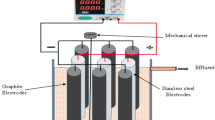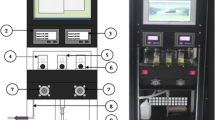Abstract
A multi-channel continuous water toxicity monitoring system was, after confirming the systems' performance, implemented to samples of water discharged from power plants to detect and classify their toxicity using several recombinant bioluminescent bacteria. Each channel of the system is composed of a series of two mini-bioreactors to enable a continuous operation, i.e., without system interruption due to highly toxic samples. A different recombinant bacterial strain was present in each channel: DPD2540 (fabA::lux CDABE), DPD2794 (recA::luxCDABE), and TV1061 (grpE::luxCDABE), which are induced by cell membrane-, DNA-, and protein-damaging agents, respectively. GC2 (lac::luxCDABE) is a constitutive strain, whose bioluminescence is reduced by an increase in cellular toxicity. Phenol and mitomycin C (MMC) were used for evaluating the system's performance to detect toxic chemicals. These samples were injected into the second mini-bioreactor according to a step or bell-curve manner. The field samples used in this study were obtained from the water discharged from two different power plants in Korea – from a nuclear power plant and a thermo-electronic power plant, and were injected into the second mini-bioreactor to initiate the toxicity test. Each channel showed specific bioluminescent (BL) response profiles due to the toxic compounds present in the water samples. Comparing the BL signals between the standard toxic chemical samples and discharged water samples, the equivalent toxicity of the field water could be estimated. Finally, it was proved that this novel continuous toxicity monitoring system can be used as an alternative tool for the quick monitoring and control of water quality, as well as aid in the setting up of a new monitoring strategy to protect the source of tap water and in the prevention of polluted water discharge.
Similar content being viewed by others
References
Allakhverdiev, S. I., Kinoshita, M., Inaba, M., Suzuki, I. and Murata, N.: 2001, ‘Unsaturated fatty acids in membrane lipids protect the photosynthetic machinery against salt-induced damage in Synechococcus’, Plant Physiol. 125, 1842–1853.
Belkin, S., Smulski, D. R., Dadon, S., Vollmer, A. C., Van Dyk, T. K. and LaRossa, R. A.: 1997, ‘A panel of stress-responsive luminous bacteria for toxicity detection’, Water Res. 31, 3009–3016.
Bitton, G. and Duntka, B. J.: 1986, ‘Introduction and Review of Microbial and Biochemical Toxicity Screening Procedures’, in: G. Bitton and B. J. Dunka (ed.), Toxicity Testing Using Microorganisms, CRC Press, Boca Raton, pp. 1–8.
Gu, M. B. and Choi, S. H.: 2001, ‘Monitoring and classification of toxicity using recombinant bioluminescent bacteria’, Water Sci. Technol. 43, 147–154.
Gu, M. B. and Gil, G. C.: 2001, ‘A multi-channel continuous toxicity monitoring system using recombinant bioluminescent bacteria for classification of toxicity’, Biosens. Bioelectron. 16, 661–666.
Gu, M. B., Gil, G. C. and Kim, J. H.: 1999, ‘A two-stage minibioreactor system for continuous toxicity monitoring’, Biosens. Bioelectron. 14, 355–361.
Gu, M. B., Kim, B. C., Cho, J. and Hansen, P. D.: 2001, ‘The continuous monitoring of field water samples with a novel multi-channel two-stage mini-bioreactor system’, Environ. Monitor. Assess. 70, 71–81.
Gil, G. C., Mitchell, R. J., Chang S. T. and Gu, M. B.: 2000, ‘A Biosensor for the detection of gas toxicity using a recombinant bioluminescent bacterium’ Biosens. Bioelectron. 15, 23–30.
Kikuchi, M. and Wakabayashi, M.: 1997, ‘Monitoring the biological effects of chemicals in river water using Daphnia magna’, Bull. Jpn. Soc. Sci. Fish 63, 633–637.
Kim, B. C., Park, K. S., Kim, S. D. and Gu, M. B.: 2003, ‘Evaluation of a high throughput toxicity biosensor and comparison with a Daphnia magna bioassay’, Biosens. Bioelectron. 18, 821–826.
Lee, H. Y., Choi, S. H. and Gu, M. B.: 2003, ‘Response of bioluminescent bacteria to sixteen azo dyes’, Biotechnol. Bioprocess Eng. 8, 101–105.
Vollmer, A. C., Belkin, S., Smulski, D. R., Van Dyk, T. K. and LaRossa R. A.: 1997, ‘Detection damage by use of Escherichia coli carrying recA::lux, uvrA::lux, or alkA::lux reporter plasmids’, Appl. Environ. Microbiol. 63, 2566–2571.
van der Schalie, W. H., Shedd, T. R., Knechtges, P. L. and Widder, M. W.: 2001, ‘Using higher organisms in biological early warning systems for real-time toxicity detection’, Biosens. Bioelectron. 7, 8, 457–465.
Van Dyk, T. K., Smulski, D. R., Reed, T. R., Belkin, S., Vollmer, A. C. and RaLossa R. A.: 1995, ‘Responses to toxicants of Escherichia coli strain carring a uspA::lux genetic fusion and E. coli strain carring a grpE::lux fusion are similar’, Appl. Environ. Microbiol. 61, 4124–4127.
Xu, X. Y., Kadokura, H., Okubo, A., Kitamoto, K. and Yamazaki, S.: 2001, ‘Cloning and sequencing of a gene encoding a novel salt stress-induced membrane protein from Rhodobacter sphaeroides f. sp. Dentrificans’, Appl. Microbiol. Biotech. 56, 442–447.
Author information
Authors and Affiliations
Rights and permissions
About this article
Cite this article
Kim, B.C., Gu, M.B. A Multi-Channel Continuous Water Toxicity Monitoring System: Its Evaluation and Application to Water Discharged from a Power Plant. Environ Monit Assess 109, 123–133 (2005). https://doi.org/10.1007/s10661-005-5843-7
Received:
Accepted:
Issue Date:
DOI: https://doi.org/10.1007/s10661-005-5843-7




